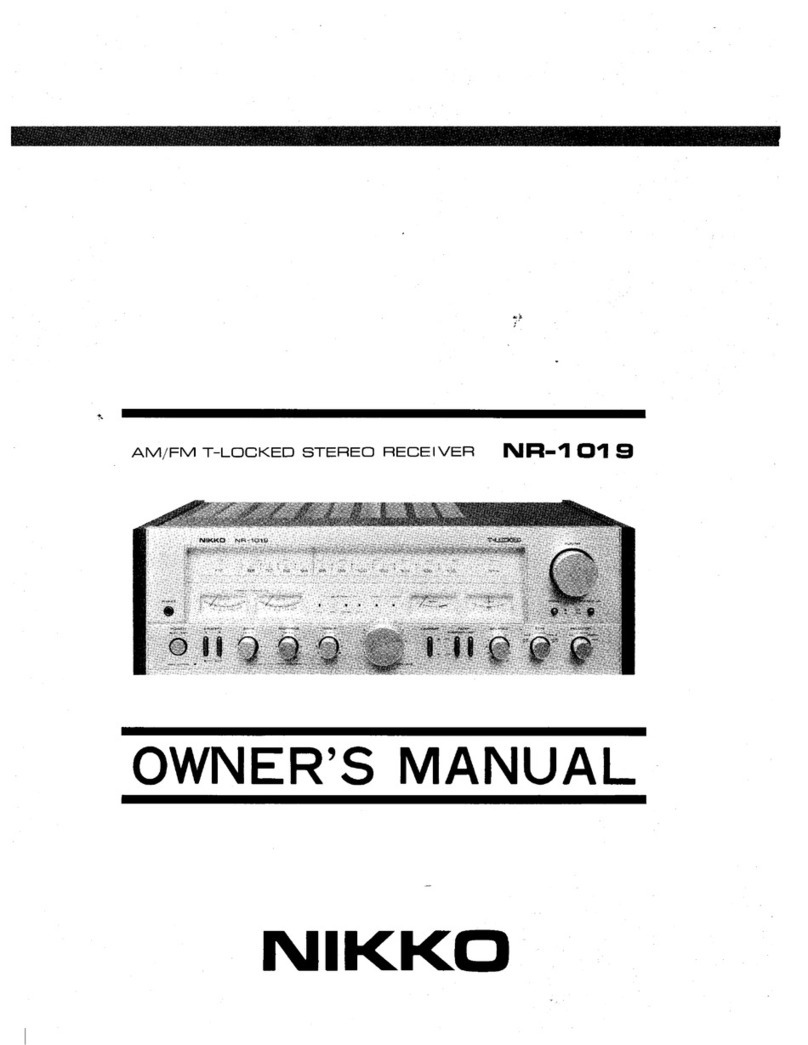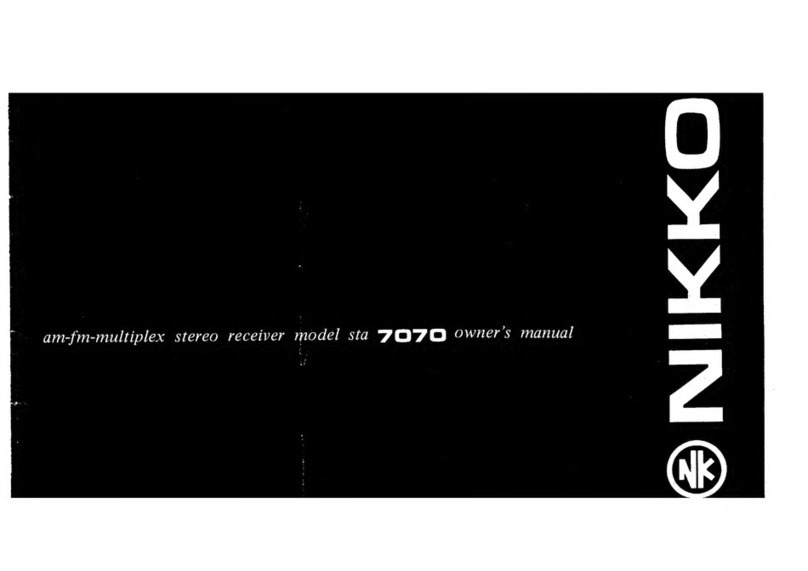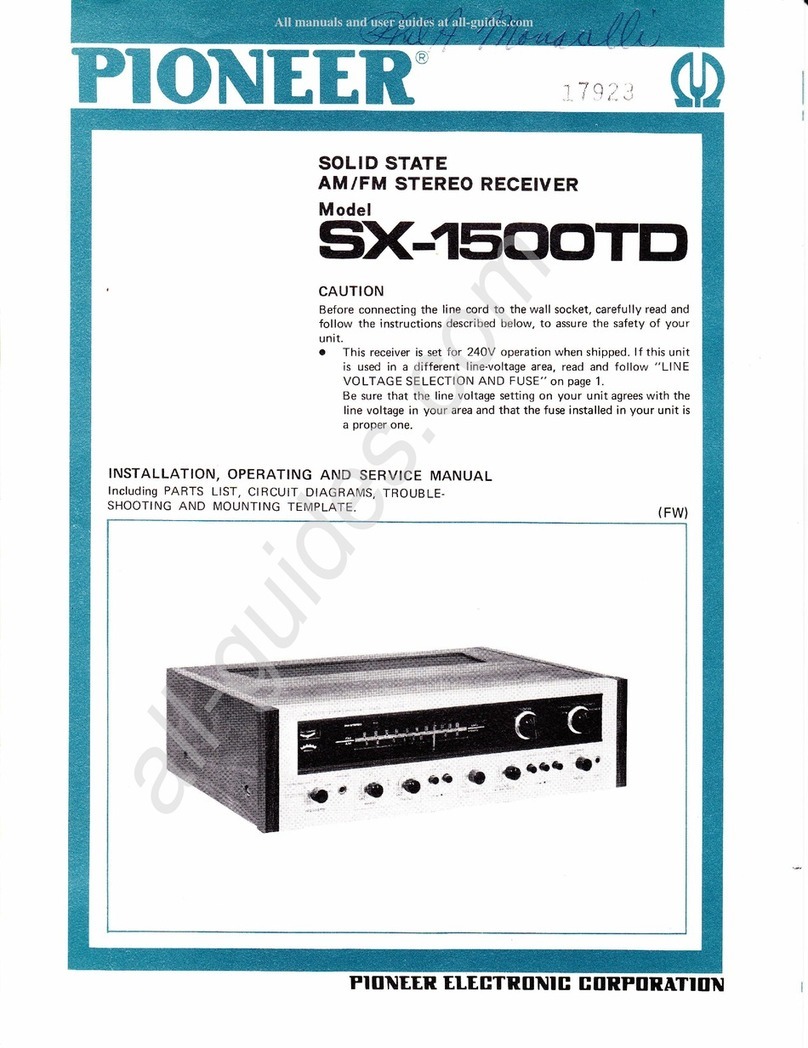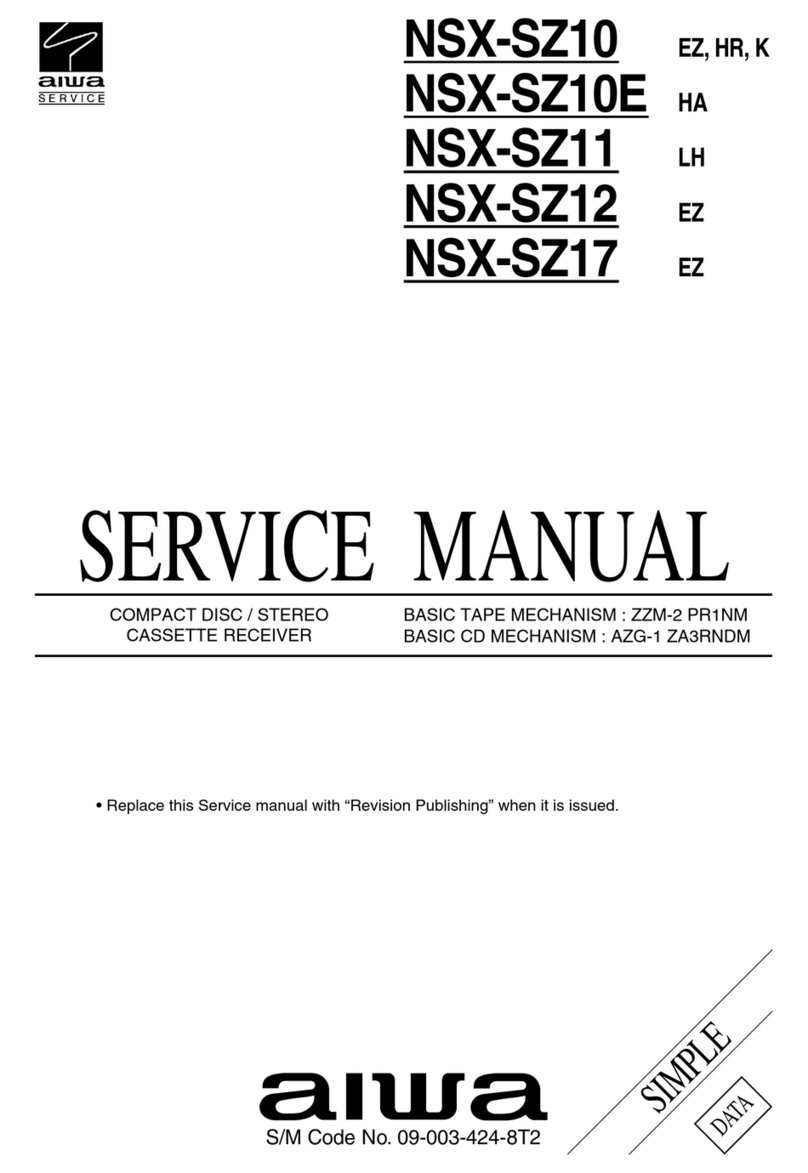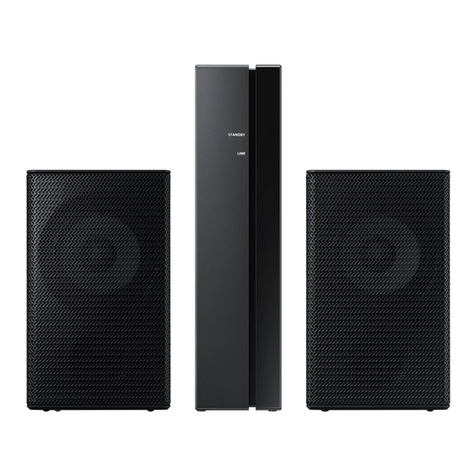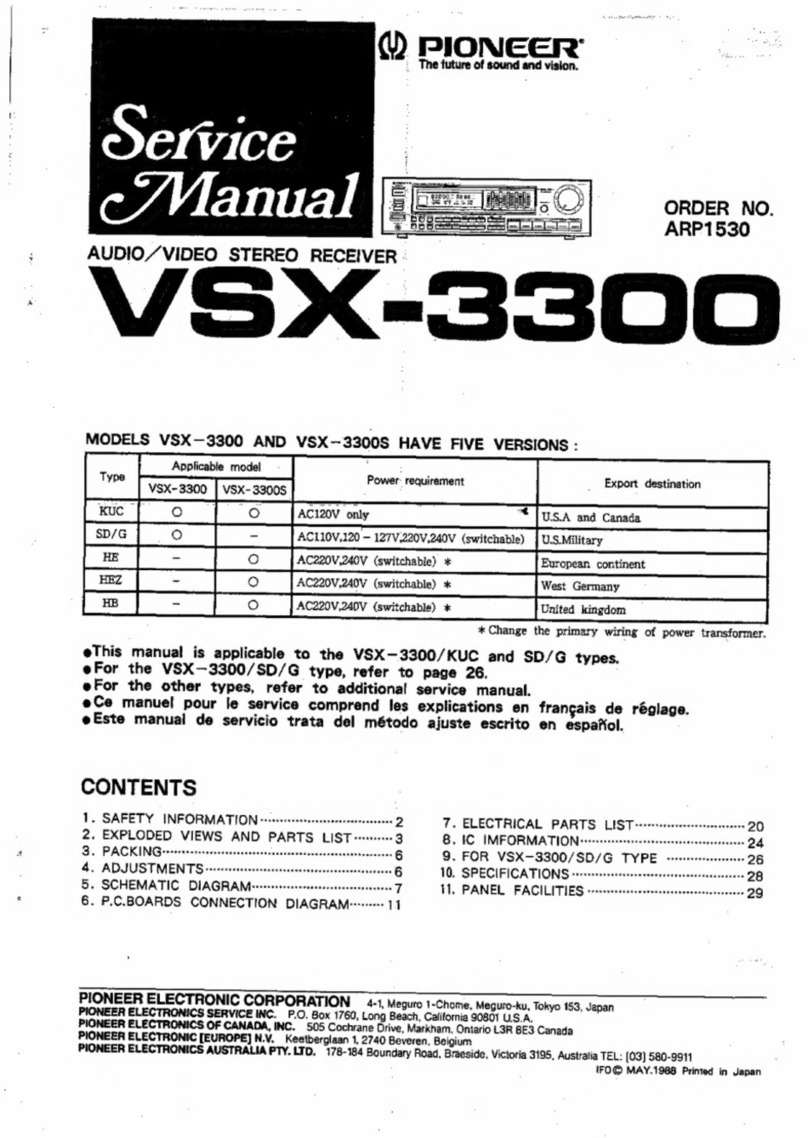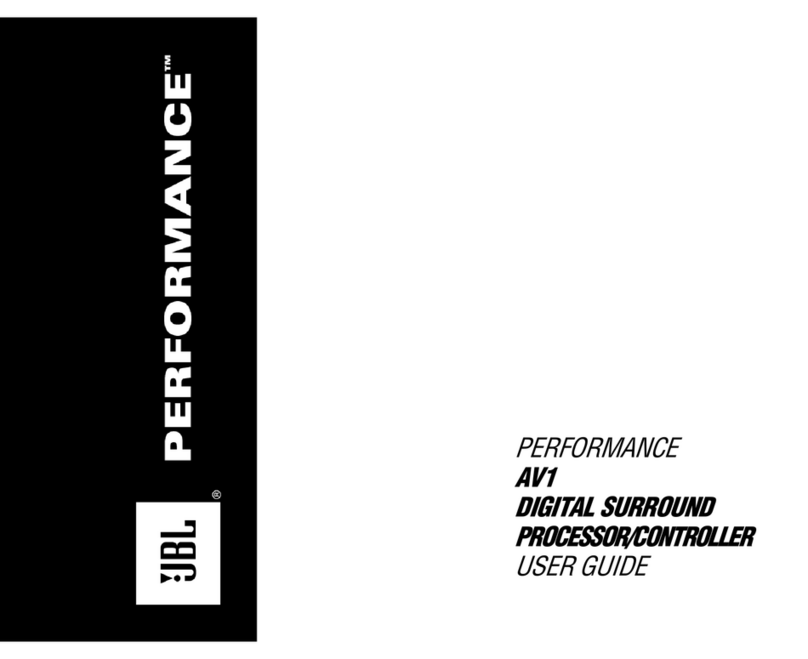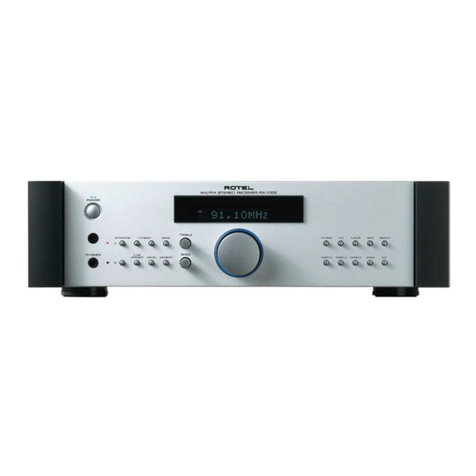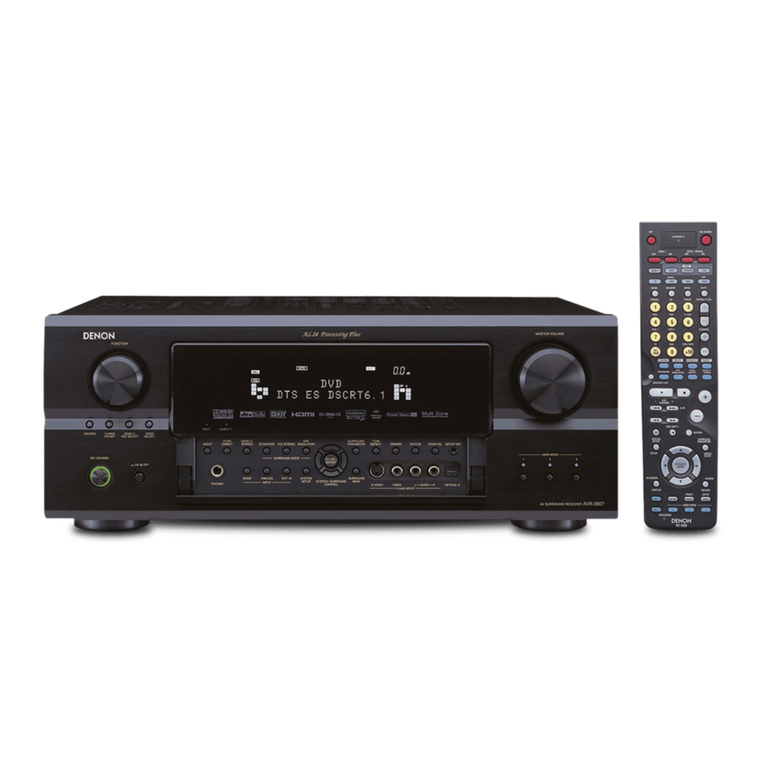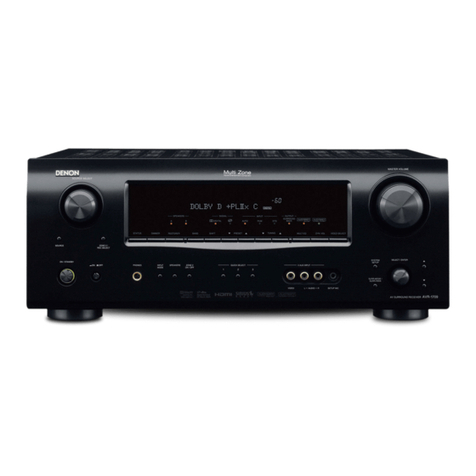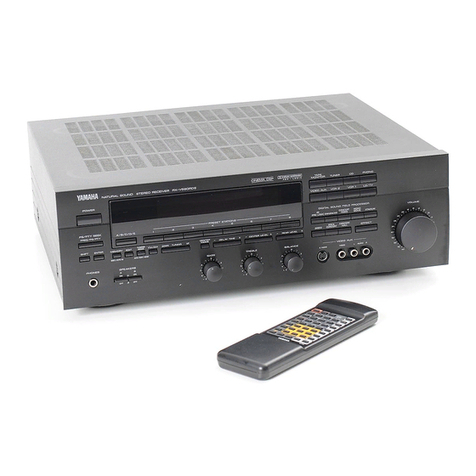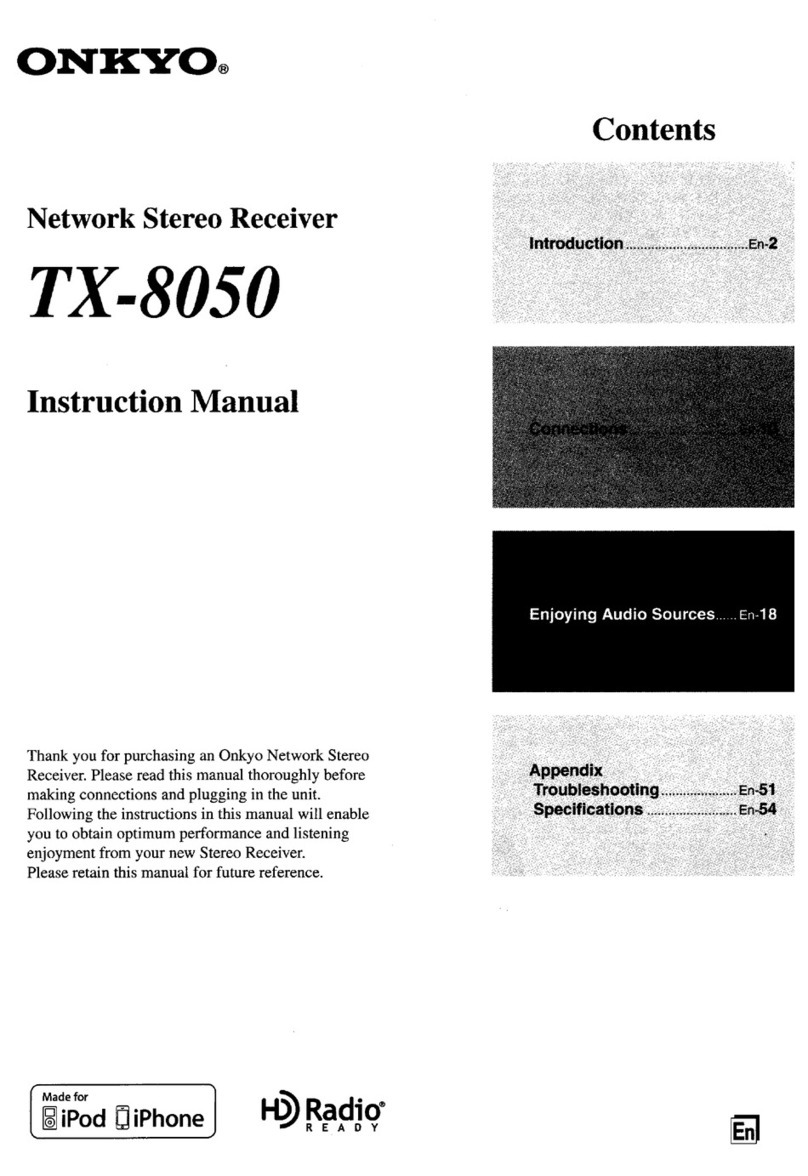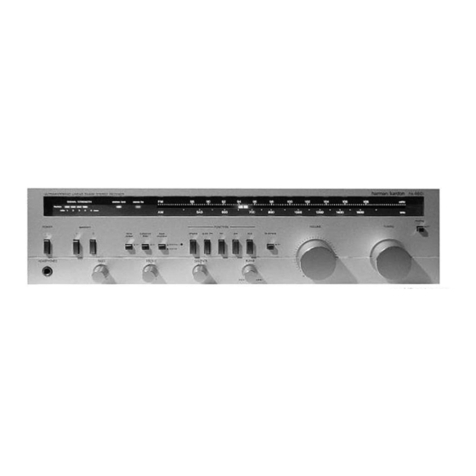Nikko STA8080 User manual


©)
POWER
SWITCH
FM
TUNER
SECTION
Sensitivity
FM
Muting
Sensitivity
Image
Rejecteon
IF
Rejection
S/N
Capture
Ratio
Distortion
Stereo
Separation
Carrier
Leak
Selectivity
AM
Suppression
Ratio
4
CH.
Composite
Output
FM
Antenna
Impedance
AM
TUNER
SECTION
Sensitivity
Image
Rejection
IF
Rejection
Selectivity
S/N
SPEAKER
HEADPHONE
BASS
TREBLE
SYSTEM
JACK
CONTROL
CONTROL
SELECTOR
LOW
HIGH
TAPE
SWITCH
FILTER
FILTER
MONITOR
SWITCH
SWITCH
SWITCH.
TAPE
1
AMPLIFIER
SECTION
IHF
2.0nV
Music
Power
|HF
8
ohms
30uV
4
ohms
at
98
MHz
80dB
RMS
Power
Rating
Single
CH.
Driven
at
98
MHz
90dB
8
ohms
60dB
4
ohms
2.548
Both
CH.
Driven
0.5%
8
ohms
at
1000
Hz
38dB
4
ohms
19
KHz
&
38
KHz
50dB8
Power
Response
+1dB
0.5%
T..H.
D.
+400
KHz
50dB
Frequency
Response
+1dB
Main
Input
AUX
Input
(FM
400
Hz
100%,
AM
1000
Hz
30%)
40dB
Distortion
Rated
Output
180mV
1W
Output
Unbalaice
300
ohm
Intermedulation
1W
Output
Balance
75
ohm
Input
Sensitivity/Impedance
{at
1000
Hz
RATED
OUTPUT)
Main
in
PHONO
1&2
S/N
=
20dB
150nV/m
AUX
1
at
1000
KHz
45dB
AUX
2
at
1000
KHz
40dB
TAPE
MON.
1
&
2
+10
KHz
25dB
S/N
PHONO
50dB
Other
SPECIFICATIONS
co
eer:
SIGNAL
FM
FREQUENCY
STRENGTH
CENTER
INDICATOR
METER
METER
DIAL
STATION
FREQUENCY
INDICATOR
Ne
STEREO
INDICATOR
TUNING
LIGHT
KNOB
BYERED
Mrz
KHz
320mV/t20K
ohm
160mV/100K
ohm
65dB
80dB
\
)
TAPE
VOLUME
FUNCTION
FM
MONITOR
CONTROL
SELECTOR
MUTING
SWITCH
(OUTER
SWITCH SWITCH
TAPE
2
KNOB)
MODE
LOUDNESS
gatANCE
SWITCH
SWITCH
=
CONTROL
(INNER
KNOB)
140W
Tone
Control
Bass
at
70
Hz
+10dB
200W
Treble
at
10
KHz
+10dB
Loudness
at
70
Hz
+
9dB
55W/55W
at
10
KHz
+5.5dB
70W/70W
Filter
Low
Filter
at
70 Hz
—
8dB
High
Filter
at
10
KHz
—7dB
45W+45W
Damping
Factor
8
ohms
30
-_
60W+60W
Power
Line
Voltage/Frequency
;
10
Hz—40
KHz
20V
(or
220V/240V)/50/60
Hz
10
Hz—50
KHz
Power
Consumption
Maximum
290W
20
Hz—50
KHz
Working
Semiconductor
Devices
0.5%
FET
2
0.1%
Cc
2
0.2%
Transistor
47
Diode
27
Dimension
Width
455m/m
18”
1100mV/100K
ohm
Depth
370m/m
14-5/8"
2.2mV/50K
ohm
HEIGHT
137m/m
5-3/8"
160mV/100K
ohm
Weight
11
kg/24
Lbs

You
have
just
approached
an
exciting
new
dimension
in
music
listening
enjoyment.
With
your
purchase
of
the
Nikko
STA-—8080
Stereo
Receiver,you
have
secured
a
measure
of
“Daily
Happiness”
for
yourself
and
your
family.
Nikko,
translated,
means
just
that...
“Daily
Happiness.”
It
is
the
job
of
this
fine
receiver
to
do
some
translating
for
you...
to
take
broadcast
electronic
impulses
and
transform
them
into
the
enveloping
experience
of
music.
To
deliver
soothing
...
stimulating...
entertaining
listening
pleasure,
making
everyday
listening
an
enjoyable
event!
This
STA-8080
StereoReceiver
is
a
sophisticated
instrument
.
..
developed
by
some
of
the
world’s
most
creative,
technically
proficient
engineers.
This
Nikko
Receiver
is
the
product
of
one
of
the
world’s
leading
electronic
component
manufacturers!
The
Nikko
STA-8080
is
designed
to
achieve
the
ultimate
in
stereophonic
performance,
incorporating
many
of
the
latest
technological
advances:
Field
Effect
Transistors
(FET)
Integrated
Circuits
(1.C.)
for
supertor
sensitivity.
Triple
Circuit
Breaker
Protection
for
malfunction-free
dependability.
This
manual
has
been
prepared
to
help
you
get
the
maximum
performance
from
your
Nikko
Receiver.
The
step-by-step
“How
To
Operate”
instructions,
Function
Explanations
and
Connection
Diagram
will
add
to
your
knowledge
. .
.and
enable
you
to
“tune
yourself
in’...
to
the
many
years
of
“Daily
Happiness”
that
lie
ahead.
PRINTED
IN
JAPAN

~
EXPLANATION
OF
FRONT
PANEL
POWER
SWITCH
Pressing
this
switch
will
permit
the
STA-8080
to
operate,
and
repressing
will
turn
this
receiver
to
“OFF”.
SPEAKER
SYSTEM
SELECTOR
SWITCH
OFF:
Turn
to
“OFF”
when
using
headphones.
A:
Turn
to
“A”
only
when
operating
A
speaker
system.
A+B:
Turn
ta
“A+B”
when
operating
A
and
B
speaker
system
simultaneously.
B:
Turn
to
“B"
when
operating
B
speaker
system,
HEADPHONE
JACK
Plug
stereo
headphone
cord
into
this
jack
for
private
or
monitoring
listening
pleasure.
'
LOW
FILTER
SWITCH
Switch
“ON”
to
eliminate
low
frequency
rumble
noise
from
incoming
signal.
HIGH
FILTER
SWITCH
Switch
“ON”
to
eliminate
high
frequency
scratch
noise
from
incoming
signal.
BASS
CONTROL
LEFT
CHANNEL
(Outer
Knob),
RICHT
CHANNEL
(Inner
Knob),
click-stops
in
5
steps
at
each
of
MIN
i
and
MAX
side.
TREBLE
CONTROL
LEFT
CHANNEL
(Outer
Knob),
adjust
this
knob
for
high
frequen-
cles.
adjust
this
knob
for
high
frequen:
cies,
click-stops
in
5
steps
at
each
of
MIN
and
MAX
side.
TAPE
MONITOR
SWITCH
TAPE
1
TAPE
DUBBING
SWITCH
TAPE
1
—
TAPE
2.
Push
down
this
switch
to
check
tape
recording
with
headphones.
RIGHT
CHANNEL
(Inner
Knob),
adjust
this
knob
for
low
frequencies.
adjust
this
knob
for
low
frequencies.
Ast
10.
11.
12.
G)
©
OO®
17
y
natty
GRO
aed
(The
tape
recorder
or
deck
should
be
equipped
with
separate
recording
and
playback
head.)
When
setting
FUNCTION
SELECTOR
SWITCH
(#12)
to
the
“DUBBING”
position,
TAPE
1
plays
and
TAPE
2
records
so
that
duplication
from
TAPE
1
to
TAPE
2
can
be
made.
TAPE
MONITOR
SWITCH
TAPE
2
TAPE
DUBBING
SWITCH
TAPE
2
—
TAPE
1.
Push
down
this
switch
to
check
tape
recording
with
headphones.
(The
tape
recorder
or
deck
should
be
equipped
with
separate
recording
and
playback
head.)
When
setting
FUNCTION
SELECTOR
SWITCH
(#12)
to
the
“DUBBING”
position,
TAPE
2
plays
and
TAPE
1
records
so
that
duplication
from
TAPE
2
to
TAPE
1
can
be
made.
In
addition
to
tape
monitoring,
4-channel
adaptor
can
be
connected.
In
this
case,
the
switch
must
be
in
the
“ON”
position.
LOUDNESS
SWITCH
Switch
in
“ON”
position
compensates
for
frequency
loss
at
low
volume
levels.
VOLUME
CONTROL
(QUTER
KNOB)
For
low
volume,
turn
left;
for
high
volume,
turn
right.
BALANCE
CONTROL
(inner
knob):
Click-stops
at
the
top
center
position.
FUNCTION
SELECTOR
SWITCH
AUX:
Select
AUX.
1
or
AUX.
2
according
to
the
output
level
of
auxiliary
accessory
to
be
used.
Turn
to
“AUX”
when
using
other
auxiliary
audio
accessories
such
as
crystal
or
ceramic
type
cartridge,
tape
recorder
with
preamplifier,
television
output,
ete.
Turn
to
“AM"
when
receiving
AM
broadcast.
Turn
to
“FM
when
receiving
FM
mono
or
multiplex
stereo
broadcast.
Turn
to
“PHONO
1”
when
playing
manual
or
automatic
record
player
equipped
with
magnetic
type
cartridge.
AM:
FM:
PHONO
1.
BTEREG
Miz
13.
14,
15.
16.
17.
18.
19.
20.
Q
@
PHONO
2.
Turn
to
“PHONO
2”
when
playing
manual
or
automatic
record
player
equipped
with
magnetic
type
cartridge.
DUBBING:
When
making
tape-to-tape
duplication,
perform
along
with
TAPE
MONITOR
SWITCH
1
or
2
turned
on
as
desired.
MODE
SWITCH
A
mode
switch
to
allow
you
to
select
Monophonic
or
Stereophonic
operation
to
fit
your
need.
FM
MUTING
SWITCH
Switch
“ON’
to
eliminate
unwanted
between
station
background
naise.
TUNING
KNOB
By
turning
this
knob,
you
select
the
desired
station
frequency.
STEREQ
INDICATOR
LIGHT
{t
lights
up,
to
visually
indicate
STEREO
FM
MULTIPLEX
broadcast
reception.
STATION
FREQUENCY
INDICATOR
Points
out
station
frequency
received.
FREQUENCY
INDICATOR
DIAL
Clear
and
easy-to-read
slide
rule
dial
that
indicates
precise
STATION
FREQUENCY
tocation,
FM
CENTER
METER
After
the
signal
strength
meter
maximum
tuning
point,
for
furth
(#
19)
is
turned
closest
to
the
er
precise
tuning,
adjust
the
tuning
knob
(
#15}
until
the
need!e
of
center
of
the
scale.
SIGNAL
STRENGTH
METER
he
zero
center
meter
points
to
the
When
Turning
Knob
(#15)
is
turned
to
desired
station,
meter
should
show
maximum
reading.

21.
22.
23.
24,
G8)
GS)
pHOON
yp
TBE
4
fe
0
FM
AND
B50008.
2
O-O
2)
g
og
AUX
2
AUKI
PHONO
2
PHONO
5
@
3
~~,
GROUND
TERMINAL
Earth
ground
connection
for
RECORD
PLAYER.
INPUT—TERMINALS
AUX—1
HIGH
LEVEL
Should
be
selected
according
to
the
output
AUX—2
LOW
LEVEL
_
level
of
auxiliary
accessory
to
be
connected.
PHONO
1
Piug
cables
of
manual
or
automatic
record
player
equipped
with
magnetic
type
cartridge
into
these
jacks.
PHONO
2
Plug
cables
of
manual
or
automatic
record
player
equipped
with
magnetic
type
cartridge
into
these
jacks.
(Should
select
PHONO
1.
or
PHONO
2
for
connection).
TAPE
IN/OUT
TERMINALS
TAPE
1.
IN:
Connect
the
output
plug
of
the
tape
deck
into
this
jack
for
playback
of
the
tape
deck
and
TAPE
MONITOR
SWITCH
(#8)
is
in
the
on
position
for
monitoring
the
recording
by
the
tape
deck.
QUT:
Connect
the
input
piug
of
the
tape
deck
into
this
jack.
TAPE
2.
IN:
Connect
the
output
plug
of
the
tape
deck
into
this
jack
for
playback
of
the
tape
deck
and
TAPE
MONITOR
SWITCH
(#8)
is
in
the
on
position
for
monitoring
the
recording
by
the
tape
deck.
QUT:
Connect
the
input
plug
of
the
tape
deck
into
this
jack.
TAPE
REC/P.B
(DIN
TYPE
CONNECTOR)
TAPE
1
This
connector
is
an
extra
input
and
output
terminal
for
European
type
recorder.
TAPE
2
This
connector
is
an
extra
input
and
output
terminal
for
European
type
recorder.
(Connect
4
-
channel
adaptor
with
TAPE
MONITOR
SWITCH
(#9)
turned
on.)
23)
os,
TAME
Z/4CH
ADAPTOR
GUT;ZCH}
INC4CH}
OUT
in
e000
25.
26.
27.
28.
29.
~
ro
an
SI
AZ
GD
UG
LEST
RIGHT
|
LEET
~
~~
Foot
TAPE!
»OO®
MAIN
IN/OUT
SWITCH
CONNECT/SEPARATE-
Must
be
set
to
the
“SEPARATE”
position
only
when
connecting
multi-amplifiers
or
4-channel
adaptor.
(See
#265.)
MAIN
INPUT/PRE
OQUTPUT/FM
4CH
OUT
PUT
TERMINAL
MAIN
INPUT
(R/L):
Main
amplifier
input
terminals;
for
use
when
it
becomes
necessary
to
bypass
the
STA-
8080
pre-amplifier.
This
function
is
ac-
complished
in
conjunction
with
switch
(#25)
located
in
the
rear
of
the
STA-
8080
Provides
output
of
pre-amplifier
signals
at
these
terminals
from
the
STA-8080
pre-
amplifier.
FM
4CH
OUTPUT:
Connect
FM
broadcast 4-channel
adaptor.
SPEAKER
TERMINALS
(SPEAKER
SYSTEM
B)
PRE
OUTPUT
(R/L):
A.
Connect
right-side
speaker
cables
to
terminals
“RIGHT”
and
“GND”.
B.
Connect
left-side
speaker
cables
to
terminals
“LEFT”
and
“GND”.
C.
“GND”
markings
are
for
correct
phasing
of
both
speakers.
SPEAKER
TERMINALS
(SPEAKER
SYSTEM
A)
A.
Connect
right-side
speaker
cables
to
terminals
“RIGHT’’
and
"GND".
B.
Connect
left-side
speaker
cables
to
terminals
“LEFT”
and
“GND”
C€.
“GNO"
markings
are
for
correct
phasing
of
both
speakers.
POWER
SUPPLY
CORD
Connect
this
cord
into
electrical
AC
receptacle.
31.
32.
33.
4.
35.
36.
EXPLANATION
OF
REAR
PANEL
6)
@
@)
@
com
uit
BREAKER,
1c
je
™
any
TOTAL
AStw
Max
NKMO
ELECTRIC
MFG.
PROD.
OF
JAPAN
RIGHT
GND
LEFT
GND
AC
OUTLET
(Unswitched)
Accessory
power
outlet.
AC
always
available
when
receiver
is
plugged
into
AC
receptacle
and
is
not
controlled
by
the
Main
Power
Switch
(#1).
Maximum
capacity
is
350
watts.
AC
OUTLET
(Switched)
This
outlet
is
connected
to,
and
turned
“ON”
and
“OFF”
by
the
Main
Power
Switch
(#1).
Maximum
capacity
is
100
watts.
CIRCUIT
BREAKER
(Primary)
The
primary
circuit
breaker
protects
the
receiver
from
major
damage
due
to
overload
or
short
circuit.
CIRCUIT
BREAKER
(Secondary)
LEFT
and
RIGHT
outputs
are
protected
against
overload
with
their
respective
circuit
Breaker
provided.
When
the
output
is
unavailable,
press
the red
reset
buttons.
When
the
circuit
breakers
reoperate
even
after
pressing
the
red
buttons,
the
STA-8080
is
in
trouble.
Check
the
speaker
output
cords
for
short-circuit.
AM
BAR
ANTENNA
Adjust
this
bar
for
optimum
AM
broadcast
reception
with
minimum
noises.
ANTENNA
TERMINALS
FM
—
FM
—
GND
AM
3002
752
Connect
balance-type
antenna
with
an
impedance
of
300
ohms
to
FM
terminals
and
unbalance-type
antenna
of
75
ohms
to
FM
and
GND
terminals.
75Q
COAXIAL
CABLE
When
the
FM
antenna
is
of
75-ohms
coaxial
cable
type,
the
outer
earth
conductor
of
the
cable
must
be
held
with
this
holder
and
the
inner
conductor
connected
to
FM
terininal.

CONNECTION
DIAGRAM
LEFT
SPEAKER
FM
ANTENNA
AM
ANTENNA
TO AC
RECEPTACLE
ed
y
@|
ee
:
5)
RIGHT
oreeey
SYSTEM
A
PHONO
2
MAGNETIC
TYPE
SYSTEM
B
RIGHT
SPEAKER
PHONO
|
MAGNETIC
TYPE
2
és
TO
AC
RECEPTACLE
TAPE
RECORDER
|
Sp
SYSTEM
B
"2
TO
AC
RECEPTACLE
LEFT
SPEAKER
TAPE
RECORDER
2

NOOR
WN>
9
10.
11,
12.
13.
14,
15.
16.
17,
18.
19,
“HOW
TO
OPERATE
~
POWER
SUPPLY
CORD
(#29)
should
be
connected
to
electrical
receptacle
after
all
other
necessary
connections
have
been
made.
Make
sure
POWER
SWITCH
(#1)
is
in
the
“OFF”
position.
Connect
speaker
to
SYSTEM
B
(#27)
or
SYSTEM
A
(#28).
Connect
other
components
to
their
respective
connectors
on
the
rear
panel.
Turn
FUNCTION
SELECTOR
SWITCH
(#12)
to
desired
position.
Set
STEREO/MONO
(MODE)
SWITCH
(#13)
to
desired
mode.
Pressing
it
down
will
turn
mode
to
mono.
Set
VOLUME
CONTROL
(#11,
outer
knob)
to
zero
position
and
BALANCE
CONTROL
(#11,
Inner
knob),
BASS
CONTROL
(#6)
and
TREBLE
CONTROL
(#7)
to
center
position.
Set
TAPE
MONITOR
SWITCH
(#8
&
9)
to
their
respective
level
positions.
Turn
LOUDNESS
SWITCH
(#
10),
FM
MUTING
SWITCH
(#
14),
LOW
FILTER
SWITCH
(#
4)
and
HIGH
FILTER
SWITCH
(#
5)
to
their
respective
LEVEL
position.
Turn
SPEAKER
SYSTEM
SELECTOR
SWITCH
(#2)
to
desired
position.
After
checking
each
of
the
instructions
above,
connect
POWER
SUPPLY
CORD
(#
29)
to
electrical
receptacle.
Press
POWER
SWITCH
(#1)
to
turn
on
the
STA8080.
Turn
VOLUME
CONTROL
(#11,
outer
knob)
to
adjust
speaker
output
levels.
Turn
BASS
CONTROL
(#6)
and
TREBLE
CONTROL
(#7)
to
adjust
low
and
high
frequencies
as
desired,
AM
RECEPTION:
Set
FUNCTION
SELECTOR
SWITCH
(#12)
to
“AM”
and
turn
TUNING
KNOB
(#
15)
until
you
catch
desired
station
with
maximum
readling
of
SIGNAL
STRENGTH
METER
(#20),
and
the
needle
of
the
zero
center
meter
(#19)
point
to
the
center
of
the
scale.
—
FM
MULTIPLEX
or
MONOPHONIC
RECEPTION:
Set
FUNCTION
SELECTOR
SWITCH
(#
12)
to
“FM”
and
turn
TUNING
KNOB
(#
15)
until
you
catch
desired
station
with
maximum
reading
of
SIGNAL
STRENGTH
METER
(#20),
and
the
needle
of
the
zero
center
meter
(#19}
point
to
the
center
of
the
scale.
MPX
STEREO
INDICATOR
LIGHT
(#16)
automatically
lights
up-when
FM
multiplex
broadcast
is
received
HIGH
FILTER
SWITCH
(#5)
should
be
in
the
“ON”
position
to
eliminate
noise
of
FM
broadcast
reception,
record
player,
tape
recorder,
Refer
to"“EXPLANATION”
for
operations
of
other
program
sources
(record
player,
tape
decks,
etc.)
NOTE:
Check
CIRCUIT
BREAKER
when
the
STA80Q80
does
not
work
even
if
all
the
necessary
connections
are
properly
made.
Push
the
reset
buttons
(#
32
&
33,
RED)
of
the
circuit
breakers.
Table of contents
Other Nikko Stereo Receiver manuals
